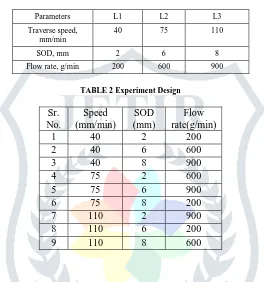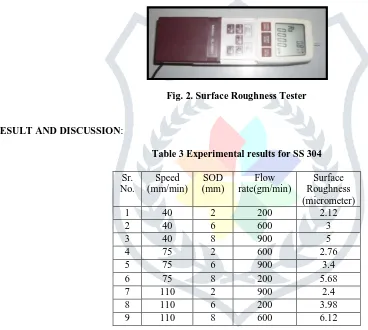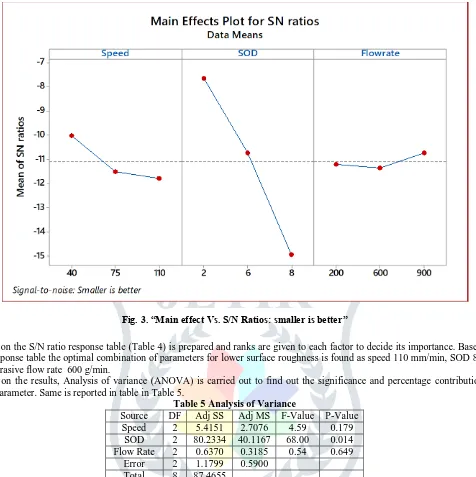Parametric Analysis of Abrasive Water Jet
Machining.
1 Sanjay C. Shah, 2 Dipesh P. Patel, 3 Bhupendra N Parmar
1 Assistant Professor, 2 Assistant Professor, 3 Production Engineer 1 Department of Mechanical Engineering,
1,2 Parul Institute of Engineering and Technology, Parul University, Vadodara, India. 3 MSSD Saudi Aramco, Saudi Arabia.
Abstract: Abrasive Water Jet Machining (AWJM) is a nontraditional machining process wherein high-pressure water jet mixed with abrasive particles strikes on the hard and difficult to cut materials (by conventional machining process). AWJM has got very wide manufacturing applications like cutting, milling, cleaning and surface treatment of metals and glass, granites like materials. Stainless Steel (SS304) possessing high strength and toughness, is usually known to offer major challenges during its cutting. In this work, Taguchi’s DOE approach is used to plan and design the experiments to study the effect of AWJM process parameter, like traverse speed, standoff distance and abrasive flow. Subsequently, using analysis of variance (ANOVA) the significance and contribution of each input parameter on surface roughness is determined.
Index Terms - AWJM, Stainless Steel, Taguchi, ANOVA, traverse speed, stand-off distance (SOD), abrasive flow rate, surface roughness.
I. INTRODUCTION
Abrasive Water Jet Machining (AWJM) is an un-conventional machining process wherein high pressure water jet mixed with abrasive particles strikes on the hard and difficult to cut materials (by conventional machining process). AWJM has got very wide manufacturing applications like cutting, milling, cleaning and surface treatment. The important thing in this process is that, it has negligible heat affected area while cutting, accuracy, comparatively good surface finish and less force exertion.
Principle of working: A focused jet of abrasive particles carried by high pressure water at a velocity ranging from 150 to 300 m/s is forced to strike on the work material through a nozzle and then work material is removed by erosion.
Usually, SiC or Al2O3 abrasive particles of the size 20µm to 50 µm are used. The water pressure of 30,000–90,000 psi (210–620
MPa) is kept. The nozzle size is of .07 to 1 mm, made of very hard material like Sapphire.
The parameters which may influence the quality of the product are: water jet pressure, focusing tube bore diameter and length, abrasive grit size, abrasive material type, abrasive flow rate, cutting parameters like traverse speed, stand-off distance, angle of attack and work material hardness and composition.
Parametric analysis of abrasive water jet machining process – In this experimentation, we have selected the process parameters as: Traverse speed, SOD and abrasive flow rate to study the their effect on surface roughness. The machining of SS304 is done on abrasive water jet machine by taking different values of these three parameters and then surface roughness is measured to find the optimum parameters on which the process can be run to achieve lower surface roughness.
II. LITERATURE REVIEW
B Satyanarayana and G Srikar worked on Inconel 718 material with process parameters as abrasive flow rate, water jet pressure, standoff distance and output as Material removal rate and kerf. They found that water jet pressure is more significant parameter for MRR and kerf [1].
Senthilkumar N. and Ananthkumar A. experimented on Stainless steel 410 with process parameters as water jet pressure, abrasive flow rate and standoff distance and output parameters as MRR and Machining time, they found that water jet pressure is more significant parameter [2].
A D Kumbhar and M Chatterjee did analysis of taper angle and straightness of the cut [3].
The work of M Sharma,H Chaudhary et al., reveals that transverse rate has a greater influence on surface roughness followed by standoff distance, water jet pressure has least effect on surface roughness and water jet pressure is the most significant parameter for MRR followed by transverse rate and standoff distance [4].
M. A. Azmir, A. K. Ahsan et al., experimented on Kelvar Composite laminate to improve surface waviness taking hydraulic pressure, abrasive mass flow rate, standoff distance and traverse rate as process parameters and they optimized the process parameters to achieve lower surface waviness [5].
M. Chithirai, N. Mohana Sundara, et al., investigated during their experimentation that as traverse speed increases, surface roughness increases, water jet pressure increases, the surface roughness improves and as abrasive flow rate increases, the surface roughness decreases, while working on Aluminium [6].
Traverse speed increases- surface roughness increases; abrasive flow rate increases- surface roughness improves; traverse speed increases- MRR increases; water jet pressure increases- MRR increases[7][9][10][13].
III. PARAMETER SELECTION
IV. EXPERIMENTAL PROCEDURE
4.1 Design of experiment
Essentially, experimentation is too lengthy and complex. It becomes rather more complicated when input parameters are more than two. Taguchi method is easy to simplify this complications, it uses design of orthogonal arrays to cover whole range of parameters. To solve this problem, the Taguchi method uses a special design of orthogonal arrays to study the entire parameter space with only a small number of experiments. Taguchi method has given optimum solutions in industry, with wide range of parameters. Taguchi method also helps to understand the behaviour of the process under study, Taguchi method saves the effort, time and cost. Taguchi method is also widely used for process, product development and system parameters and tolerance design. To understand the impact and contribution of the parameters, ANOVA can be employed and hence optimal levels of parameters on surface roughness can be found. In the present study, three factors each at three levels are considered to perform the experimentation work. Based on Taguchi method L9 orthogonal array has been selected. Table 1, gives the levels and factors which are employed for machining the samples. Experiments design matrix is listed in Table 2.
TABLE 1 Factors and their Levels
Parameters L1 L2 L3
Traverse speed, mm/min
40 75 110
SOD, mm 2 6 8
Flow rate, g/min 200 600 900
TABLE 2 Experiment Design
Sr. No.
Speed (mm/min)
SOD (mm)
Flow rate(g/min)
1 40 2 200
2 40 6 600
3 40 8 900
4 75 2 600
5 75 6 900
6 75 8 200
7 110 2 900
8 110 6 200
9 110 8 600
4.2 Experimental Setup
The set up is used for machining of different material depends on different control parameters available is showhn in figure 3.1. The main parts of the machine are:Electric power supply (230-240 V); Pressure generating system (pump) (37 kw); Work piece-SS 304 material; CNC controller (siemens with NEW-CAM software); Work table (1500×2000×150 mm); Nozzel set up (with control of 100 to 1000 gm); Abrasive feeder (capacity of 170 liters).
Fig: 1 Schematic diagram of working system of AWJM
Cutting table:
Cutting table of abrasive water jet machine is shown in figure 1.
The general domain of parameters AWJ machining system is given below:
Orifice – Sapphires – 0.1 to 0.3 mm; Focusing Tube – WC – 0.8 to 2.4 mm; Pressure – 2500 to 4000 bar; Abrasive – garnet and silica sand - #125 to #60; Abrasive flow - 0.1 to 1.0 Kg/min; Standoff distance – 1 to 10 mm; Machine Impact Angle – 600 to 900;
Traverse Speed – 10 mm/min to 1000 m/min; Depth of Cut – 1 mm to 250 mm.[15]
Work piece Material: Stainless Steel 304 (SS304) Composition of SS304:
C-.03%, Si-1%, Mn-2%, P-0.45%, S-0.03%, Cr-18 to 20%, Ni- 8 to 12%. Properties of SS304:
Tensile Strength – 515 MPa, Yeild Striength – 205 MPa, Elongation – 40% in 50 mm, Hardness – Rockwell B 92, Brineell Hardness – 201
Abrasive: SiO2.
Specification of surface roughness tester:
Model : mitutoyo SJ 201; Range : 49” (12.5 mm); Control unit : 156×62×52 mm; Mass : 0.3 kg; Measuring speed : 0.25 to 0.5 mm/sec.; Measuring force : 4 mN; Stylus tip : diamond,90˚/5 µmR; Skid radius of curvature : 40 mm
Fig. 2. Surface Roughness Tester
V. RESULT AND DISCUSSION:
Table 3Experimental results for SS 304
Sr. No.
Speed (mm/min)
SOD (mm)
Flow rate(gm/min)
Surface Roughness (micrometer)
1 40 2 200 2.12
2 40 6 600 3
3 40 8 900 5
4 75 2 600 2.76
5 75 6 900 3.4
6 75 8 200 5.68
7 110 2 900 2.4
8 110 6 200 3.98
9 110 8 600 6.12
Table 4 Response Table for Signal to Noise Ratios “Smaller is better”
Fig. 3. “Main effect Vs. S/N Ratios: smaller is better”
Based on the S/N ratio response table (Table 4) is prepared and ranks are given to each factor to decide its importance. Based on the response table the optimal combination of parameters for lower surface roughness is found as speed 110 mm/min, SOD 8 mm and abrasive flow rate 600 g/min.
Based on the results, Analysis of variance (ANOVA) is carried out to find out the significance and percentage contribution of each parameter. Same is reported in table in Table 5.
Table 5 Analysis of Variance
Source DF Adj SS Adj MS F-Value P-Value Speed 2 5.4151 2.7076 4.59 0.179
SOD 2 80.2334 40.1167 68.00 0.014 Flow Rate 2 0.6370 0.3185 0.54 0.649
Error 2 1.1799 0.5900 Total 8 87.4655
As per the data SOD found as significant parameter based on P value (0.014). Also the contribution is 68 percentages. Hence one can say that SOD has more influence on surface roughness and that speed and abrasive flow rate are less significant parameters.
VI. CONCLUSION
Based on ANOVA table it is observed that standoff distance is the most significant parameter. Also it is clear from the ANOVA, that speed and abrasive flow rate are less significant coparatively in Abrasive Water Jet Machining process.
Optimum Values of Parameters: SOD: 8 mm;
Traverse Speed: 110 mm/min; Abrasive Flow Rate: 600 g/min.
ACKNOWLEDGMENT
The authors are thankful to A innovative international, Sarkhej Bavla highway, Ahmedabad for providing the facilities for preparing samples and conducting the tests
REFERENCES
[5] M. A. Azmir, A. K. Ahsan, et. al, “Optimization of Abrasive Water Jet Machining Process Parameters Using Orthogonal Array With Grey Relational Analysis”, Regional Conference EM3ARC2007, pp. 21-30, 2007.
[6] M. Chithirai Pon Selvan, N. Mohana Sundara Raju, et al., “Effects of Process Parameters on Surface Roughness in Abrasive Water Jet Cutting of Aluminium”, Front. Mech. Eng. 7(4), pp 439-444,2012.
[7] Chirag M. Parmar, Pratik K. Yogi, et al., “Optimization of Abrasive Water Jet Machine Process Parameter for AL-6351 usinig Taguchi Method”, IJAERD, vol. 1, issue 5, pp 1-8, 2014.
[8] Jignesh K Patel, Abdulhafiz A Shaikh, “The Influence of Abrasive Water Jet Machining Parameters on Various Responses – A Review”, International Journal of Mechanical Engineering & Rob.Res., vol.4, pp-383-403, 2015.
[9] M. Sibichakkravarthi, P. Udayakumar, et al., “A Review on Optimization Techniques of Abrasive Water Jet Machining”,
IRJET,pp 423-429, vol. 03, issue 10, October, 2016.
[10] Pravin R. Kubadel, Palash Patil, et al., “Parametric Optimization of Abrasive Water Jet Machining of Inconel-718 Material”,
IRJET, pp 1236-1242 vol. 03, issue 08, August, 2016, p-ISSN:2395-0072.
[11] Jigar A. Patel, Arvind K. Gothwal, “Optimization of Water Jet Mavhining Process Parameters Using Particle Swarm Optimization”, International Journal of Mechanical and Industrial Technology, issue 1, pp: 94-101, 2015.
[12] Miraslav Duspara, Valnea Stracevic, et al., “Optimization of Abrasive Water Jet Machining Process Parameters” Original Scientific Paper, pp 143-149, ID: TG-20171101192113.
[13] Leeladhar Nagdeve, Vedansh Chaturvedi, et al., “Implementation of Taguchi Approach for Optimization of Abrasive Water Jet Machining Process Parameters”, pp 9-13, International Journal of Instrumentation, Control and Automation 1, no. 3 (2012): 4
[14] Ross Phillip J ,Taguchi Techniques for Quality Engineering, Tata McGraw-Hill Int., Singapore, 1996.
[15] Manufacturing-process-ii-total-book-from-iit-kharagpur, Available online https://mechzoneblog.files.wordpress.com/ 2017/08/ manufacturing-process-ii-total-book-from-iit-kharagpur.pdf, Accessed on 17th January 2019.
[16]Kumar, G.K. and Sankar, C.B., “Optimization of Abrasive Water Jet Machining Process Parameters for Inconel-825 By
Using Grey Taguchi Method” IJSRSET, vol. 4, Isuue 10, pp 248-261, 2018.


